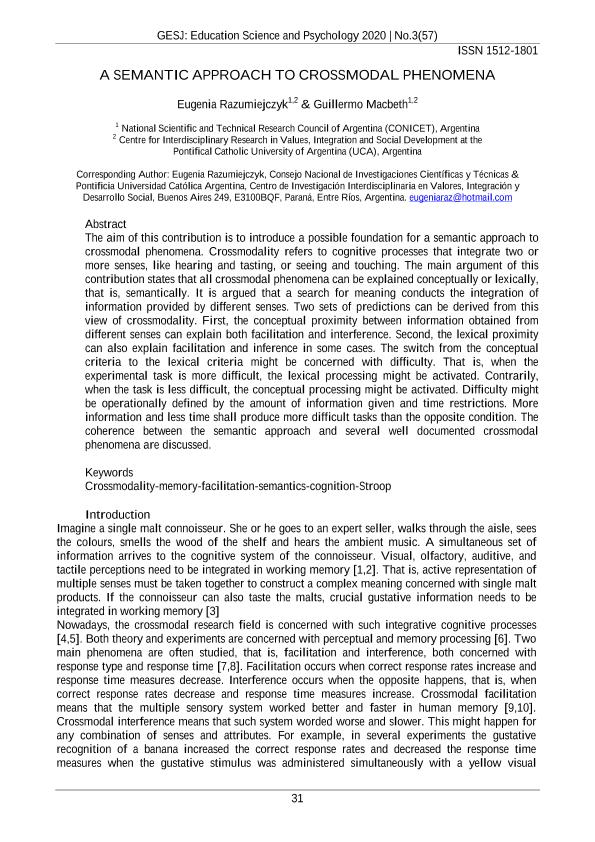Mostrar el registro sencillo del ítem
dc.contributor.author
Razumiejczyk, Eugenia

dc.contributor.author
Macbeth, Guillermo Eduardo

dc.date.available
2022-05-06T18:43:34Z
dc.date.issued
2020-12
dc.identifier.citation
Razumiejczyk, Eugenia; Macbeth, Guillermo Eduardo; A semantic approach to crossmodal phenomena; Georgian Technical University; Education Sciences and Psyhology; 57; 3; 12-2020; 31-36
dc.identifier.issn
1512-1801
dc.identifier.uri
http://hdl.handle.net/11336/156837
dc.description.abstract
The aim of this contribution is to introduce a possible foundation for a semantic approach to crossmodal phenomena. Crossmodality refers to cognitive processes that integrate two or more senses, like hearing and tasting, or seeing and touching. The main argument of this contribution states that all crossmodal phenomena can be explained conceptually or lexically, that is, semantically. It is argued that a search for meaning conducts the integration of information provided by different senses. Two sets of predictions can be derived from this view of crossmodality. First, the conceptual proximity between information obtained from different senses can explain both facilitation and interference. Second, the lexical proximity can also explain facilitation and inference in some cases. The switch from the conceptual criteria to the lexical criteria might be concerned with difficulty. That is, when the experimental task is more difficult, the lexical processing might be activated. Contrarily, when the task is less difficult, the conceptual processing might be activated. Difficulty might be operationally defined by the amount of information given and time restrictions. More information and less time shall produce more difficult tasks than the opposite condition. The coherence between the semantic approach and several well documented crossmodal phenomena are discussed.
dc.format
application/pdf
dc.language.iso
eng
dc.publisher
Georgian Technical University
dc.rights
info:eu-repo/semantics/openAccess
dc.rights.uri
https://creativecommons.org/licenses/by/2.5/ar/
dc.subject
MEMORY
dc.subject
CROSSMODALITY
dc.subject
FACILITATION
dc.subject
STROOP
dc.subject
SEMANTIC
dc.subject
COGNITION
dc.subject.classification
Psicología

dc.subject.classification
Psicología

dc.subject.classification
CIENCIAS SOCIALES

dc.title
A semantic approach to crossmodal phenomena
dc.type
info:eu-repo/semantics/article
dc.type
info:ar-repo/semantics/artículo
dc.type
info:eu-repo/semantics/publishedVersion
dc.date.updated
2022-05-02T17:14:57Z
dc.journal.volume
57
dc.journal.number
3
dc.journal.pagination
31-36
dc.journal.pais
Georgia

dc.description.fil
Fil: Razumiejczyk, Eugenia. Consejo Nacional de Investigaciones Científicas y Técnicas; Argentina. Pontificia Universidad Católica Argentina "Santa María de los Buenos Aires". Facultad Teresa de Ávila. Centro de Investigación Interdisciplinar en Valores, Integración y Desarrollo Social; Argentina
dc.description.fil
Fil: Macbeth, Guillermo Eduardo. Consejo Nacional de Investigaciones Científicas y Técnicas; Argentina. Pontificia Universidad Católica Argentina "Santa María de los Buenos Aires". Facultad Teresa de Ávila. Centro de Investigación Interdisciplinar en Valores, Integración y Desarrollo Social; Argentina
dc.journal.title
Education Sciences and Psyhology
dc.relation.alternativeid
info:eu-repo/semantics/altIdentifier/url/http://gesj.internet-academy.org.ge/en/list_artic_en.php?b_sec=edu&issue=2020-12
Archivos asociados
